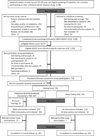A Randomized Controlled Trial of a Telephone Intervention for Alcohol Misuse With Injured Emergency Department Patients
- PMID: 26585044
- PMCID: PMC4724518
- DOI: 10.1016/j.annemergmed.2015.09.021
A Randomized Controlled Trial of a Telephone Intervention for Alcohol Misuse With Injured Emergency Department Patients
Abstract
Study objective: We conduct a randomized controlled trial to test efficacy of a telephone intervention for injured emergency department (ED) patients with alcohol misuse to decrease alcohol use, impaired driving, alcohol-related injuries, and alcohol-related negative consequences.
Methods: ED patients screening positive for alcohol misuse were randomized to a 3-session telephone brief motivational intervention on alcohol, delivered by a counselor trained in motivational interviewing during 6 weeks, or a control intervention of a scripted home fire and burn safety education delivered in 3 calls. Patients were followed for 12 months and assessed for changes in alcohol use, impaired driving, alcohol-related injuries, and alcohol-related negative consequences.
Results: Seven hundred thirty ED patients were randomized; 78% received their assigned intervention by telephone, and of those, 72% completed 12-month assessments. There were no differential benefits of telephone brief motivational intervention versus assessment and a control intervention in all 3 variables of alcohol use (frequency of binge alcohol use during the previous 30 days, maximum number of drinks at one time in the past 30 days, and typical alcohol use in the past 30 days), alcohol-impaired driving, alcohol-related injuries, and alcohol-related negative consequences.
Conclusion: Despite the potential advantage of delivering a telephone brief motivational intervention in not disrupting ED clinical care, our study found no efficacy for it over an assessment and control intervention. Potential causes for our finding include that injury itself, alcohol assessments, or the control intervention had active ingredients for alcohol change.
Trial registration: ClinicalTrials.gov NCT01326169.
Copyright © 2015 American College of Emergency Physicians. Published by Elsevier Inc. All rights reserved.
Conflict of interest statement
None of the authors have any conflicts of interest to report
Figures
References
-
- WHO. World Health Organization; 2007. Alcohol and injury in emergency departments: summary of the report from the WHO collaborative study on alcohol and injuries.
-
- American College of Surgeons COT. Resources for optimal care of the injured patient. 2006 - PubMed
-
- National Highway Traffic Safety Administration. Partners in Progress: Joining Together Against Impaired Driving. Ann Emerg Med. 1997 Dec;30:816–817. - PubMed
-
- National Institute on Alcohol Abuse and Alcoholism. Helping Patients Who Drink Too Much: A Clinican's Guide. Washington, DC: U.S. DHHS; 2007.
-
- Alcohol Screening in the Emergency Department. ACEP, 2005. [Accessed January 28, 2015]; at http://www.acep.org/Clinical---Practice-Management/Alcohol-Screening-in-....
Publication types
MeSH terms
Associated data
Grants and funding
LinkOut - more resources
Full Text Sources
Other Literature Sources
Medical
Miscellaneous



